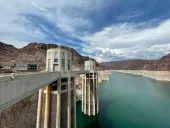What island sentinels predict about renewable energy grid reliability
By Foerd AmesFossil hydrocarbon and gas combustion has provided the bulk of power distribution reliability for over one century. Seemingly profitable unidirectional flow, from extraction to aerosolized dispensation, disavowed true cost of deleterious atmospheric and organic consequence.
Dominant Asian economies are aggressively tightening environmental policy, regulating pricing, and astonishing the world with recent levels of RE renewable energy investment. Some portend generation intermittency in proportion to RE grid integration.
Indeed, broken gearboxes and promises stall half my town’s wind turbines exceeding one year. Conversely, Germany wind overage cannot be accommodated on neighbor networks.
Fits and starts of our transition grab headline fodder. Despite Fukushima, and more recent problems, nuclear expansion seems emboldened as “all-of-the-above” strategies cling to failing wasteful principle. Last December, Philippine Department of Energy proposed $1 billion initial payment. Its Energy Secretary stated “nuclear energy is cheaper and more environment-friendly”.
Several factors deflate knee-jerk temptation. Exponentially increasing RE technology efficiency and quantity reduce cost. Other wind turbines spin, or solar panels absorb, while even more redundant RE systems and services come on line.
Adapting the continental ideal has been especially difficult for islands, peninsulas, and off-grid regions. Already contending high energy import costs, water-world developing states forefront amplified dilemma: whatever their size, intrinsically, ground-based RE and hydropower compete other precious land use. Marine wind conversion is advancing.
Yet many conventional energy deficient islands and peninsulas have MHK marine hydrokinetic energy wealth. Power-packed waves pass offshore from over 23,000 isles dotting the Pacific Ocean.
Indonesia, Japan, Java, Malaysia, Myanmar, Oceania, Papua New Guinea, Philippines, Sumatra, Taiwan, and others large and small are naturally shaped to have among the world's most enviable "slenderness ratio" of land, society, and infrastructure fronting high density ocean waves.
China’s Twelfth Five-Year Plan for Development of Marine Economy (2011-2015) directly addresses this important opportunity. The National Plan for Islands Protection promotes marine renewable energy to improve remote islands sustainability. Wave energy installations can electrify coastal communities, fishery, and off-grid locations. Other benefits include local employment in the growing MHK industry.
Demonstration projects are deploying in relatively shallow waters near Dawanshan and Hailv islands. In Honolulu, 9-11 September, the Asian Pacific Clean Energy Summit convenes the Islands & Isolated Communities Congress. The international summit focuses on a Global Islands Solutions Challenge relating to energy and water.
Marine hydrokinetics build-out could be expected from several successful demonstrations. Specific examination is required of landfall integration, annual wave conditions, and water depth correlation to MHK cost. Conditions are more complex than those reported for India.
Several island and slender peninsula isolations accompany sharp, deep drop-off. Moorings must be placed in select shelf clear of landfall yet near along numerous seamounts. Notable issue involves siting about offshore delicate ecosystems, spawning areas, and cetacean migratory routes. Sensitivity for some levels of bio-growth may enhance or help restore habitat about shade casting MHK structures.
As countless are beautiful islands, a “many-to-many” approach provides nearby manageable portions of MHK arrays that sum-totally comprise spread networks. Their spatially discrete environmental sensors collectively form neural pathways to produce accurate weather force-casts. Near real-time, wide area wave mapping is presently so reliable to enable seven day prediction.
Within populated MHK matrices, finer granularity and dense data resolution render machine level proprioception. Even within complex seas, just-in-advance of effective waves, dynamic Internet monitored controls precisely tune each buoy driven electrical generator to extract maximal forces from next waves. Intelligent networks map variable distributed generation and transmission.
Smart grids optimize RE dispatch response to moderate congestion. Supercapacitors, batteries, and increasing hydrogen cell densities help mediate grid parity. (High voltage) DC transient over-current electrolyzes additional purified water and faults trigger hydrogen release.
Gas storage and container transport, while more packeted than undersea lines, obviates long distance, inter-island, hardwire hopscotch. Industrial wave conversion is important asset for Asian Pacific regions. If well connected, growing island independence symbiotically supplies more reliable power to mainland grids.
The author is Wave Power Technologies And Application session chair/speaker at World Congress of Oceans, 23-25 September, Hangzhou, China.




















 Advertise
Advertise






